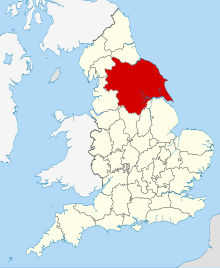
Back Yorkshire Afrikaans Eoforwicsċīr ANG يوركشاير Arabic يوركشير ARZ Ёркшыр Byelorussian Ёркшыр BE-X-OLD Йоркшър Bulgarian Yorkshire Breton Yorkshire Catalan Йоркшир CE
| Yorkshire | |
|---|---|
| Area and historic county | |
 Location of Yorkshire from 1851 | |
| Area | |
| • Coordinates | 54°N 1°W / 54°N 1°W |
| History | |
| • Origin | Kingdom of Jórvík |
| • Succeeded by | Various |
| Status | Historic county |
| Chapman code | YKS |
| Contained within | |
| • Region (most of) | Yorkshire and the Humber |
| • Ceremonial counties (most of) | North Yorkshire • East Riding of Yorkshire • South Yorkshire • West Yorkshire |
| • Ceremonial counties (part of) | Greater Manchester • Lancashire • Cumbria • County Durham |
| Subdivisions | |
| • Type | Ridings (largest & most notable of differing former subdivisions) |
| • Units | 1 North • 2 West • 3 East |
 | |
Yorkshire (/ˈjɔːrkʃər, -ʃɪər/ YORK-shər, -sheer) is an area of Northern England which was historically a county.[1] Despite no longer being used for administration, Yorkshire retains a strong regional identity.[2] The county was named after its original county town, the city of York.
The south-west of Yorkshire is densely populated, and includes the cities of Leeds, Sheffield, Bradford, Doncaster and Wakefield. The north and east of the county are more sparsely populated, however the north-east includes the southern part of the Teesside conurbation, and the port city of Kingston upon Hull is located in the south-east. York is located near the centre of the county. Yorkshire has a coastline to the North Sea to the east. The North York Moors occupy the north-east of the county, and the centre contains the Vale of Mowbray in the north and the Vale of York in the south. The west contains part of the Pennines, which form the Yorkshire Dales in the north-west.
The county was historically bordered by County Durham to the north, the North Sea to the east, Lincolnshire, Nottinghamshire, Derbyshire, and Cheshire to the south, and Lancashire and Westmorland to the west. It was the largest by area in the United Kingdom.[3] From the Middle Ages the county was subdivided into smaller administrative areas; the city of York was a self-governing county corporate from 1396, and the rest of the county was divided into three ridings – North, East, and West. From 1660 onwards each riding had its own lord-lieutenant, and between 1889 and 1974 the ridings were administrative counties. There was a Sheriff of Yorkshire until 1974. Yorkshire gives its name to four modern ceremonial counties: East Riding of Yorkshire, North Yorkshire, South Yorkshire, and West Yorkshire, which together cover most of the historic county.[a]
Yorkshire Day is observed annually on 1 August and is a celebration of the general culture of Yorkshire, including its history and dialect.[4] Its name is used by several institutions, for example the Royal Yorkshire Regiment of the British Army,[5] in sport, and in the media. The emblem of Yorkshire is a white rose, which was originally the heraldic badge of the British royal House of York. The county is sometimes referred to as "God's own country".[6] Yorkshire is represented in sport by Yorkshire County Cricket Club and Yorkshire Rugby Football Union.
- ^ Allen, Liam (1 August 2006). "What's so special about Yorkshire?". BBC. Archived from the original on 12 January 2008. Retrieved 15 July 2008.
- ^ "Yorkshire strength of identity revealed by survey answers". BBC News. 30 July 2021. Retrieved 4 January 2024.
- ^ Gibbons, G. (1969). "Yorkshire: Britain's Largest County". Geographica Ltd. London.
- ^ "Yorkshire Day". Army.mod.uk. 18 February 2008. Archived from the original on 14 January 2009. Retrieved 3 October 2008.
- ^ "New Yorkshire Regiment is formed". BBC News. 6 June 2006. Archived from the original on 25 June 2006. Retrieved 8 October 2008.
- ^ Rushby, Kevin (3 September 2013). "Yorkshire – God's own country is the best place in Europe". The Guardian. ISSN 0261-3077. Retrieved 5 January 2024.
Cite error: There are <ref group=lower-alpha> tags or {{efn}} templates on this page, but the references will not show without a {{reflist|group=lower-alpha}} template or {{notelist}} template (see the help page).







